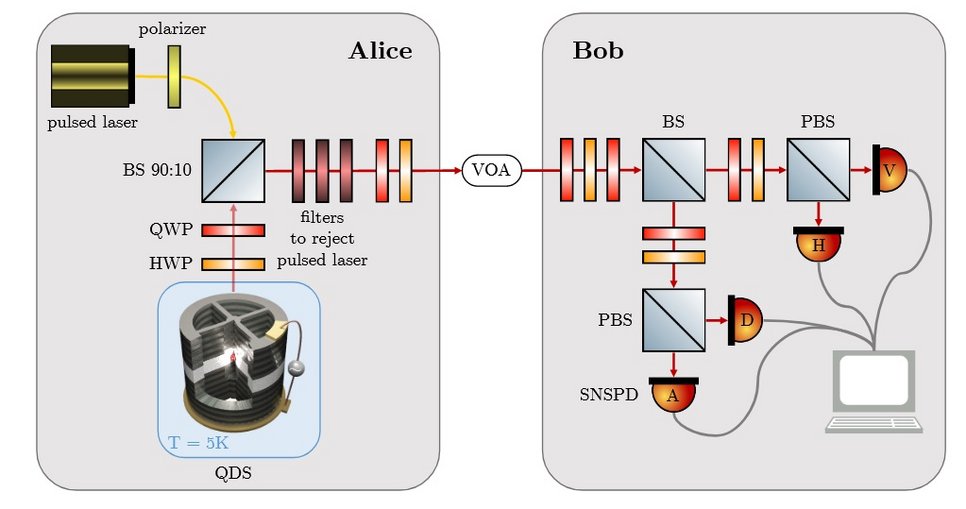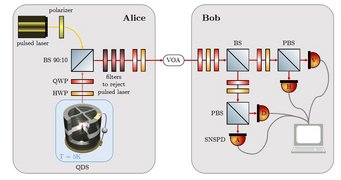Group Seminar at LMU: Enhancing Quantum Key Distribution with single-photon sources based on semiconductor quantum dots
Tim Hebenstreit,University of Jena
Group Seminar at LMU and zoom
Monday, April 24th, 09:00am (MEZ)
Abstract:

the polarization of the detected light. (P)BS: (polarizing) beam splitter.
B84 with quantum dot sources in LA excitation
The field of Quantum Technologies is a research area which is largely emerging in recent years. There is a wealth of promising real-world applications – one of them being Quantum Key Distribution (QKD). The first QKD scheme by Bennett and Brassard from 1984 is still a primitive and test bed for QKD experiments. [1] Recent theoretical work from Bozzio et al. has shown that quantum dot sources (QDS) in longitudinal phonon-assisted (LA) excitation can outperform Poisson-distributed sources (PDS) such as attenuated lasers that are usually used. [2] Within this work we plan to test the BB84 protocol with such quantum dot sources in LA excitation to demonstrate the improved distance scaling with respect to PDS. [3] Figure 1 shows the setup built to carry out the demonstration. Alice is operating the QDS and sends the single-photons to Bob. She encodes information in the polarization basis using a quarter- and a half-wave plate (QWP, HWP). The quantum channel between Alice and Bob is simulated using a variable optical attenuator (VOA). Bob on the receiving side operates a polarimeter which can measure the polarization of the photon sent by Alice. For the detection of the single-photons he uses high efficient (>90 %) superconducting nanowire single-photon detectors (SNSPD). We expect to demonstrate that QDS are able to outperform PDS in terms of secret key rate when the collection efficiency η from the QDS is above a threshold of 34 %. [2] This would allow for a better distance-scaling of QKD.
[1] Charles H. Bennett and Gilles Brassard. “Quantum cryptography: Public key distribution and coin toss-
ing”. In: Theoretical Computer Science 560.P1 (Dec. 2014), pp. 7–11. DOI: 10.1016/J.TCS.2014.
05.025.
[2] Mathieu Bozzio et al. “Enhancing quantum cryptography with quantum dot single-photon sources”. In:
npj Quantum Information 8.1 (Sept. 2022), pp. 1–8. DOI: 10.1038/s41534-022-00626-z.
[3] Sarah E. Thomas et al. “Bright Polarized Single-Photon Source Based on a Linear Dipole”. In: Physical
Review Letters 126.23 (June 2021), p. 233601. DOI: 10.1103/PhysRevLett.126.233601.
